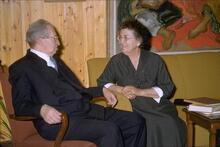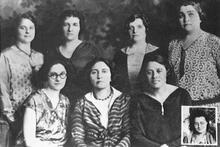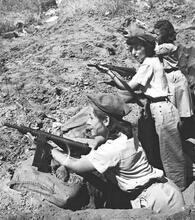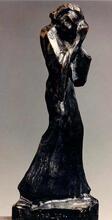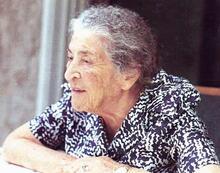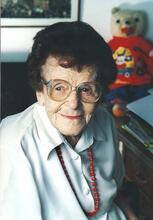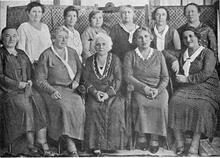Rose Viteles
Born in New York City and raised in Cincinnati, Rose Viteles had little to no connection to her Jewish heritage. Viteles’ father, in a rebuke to his yeshiva education, made no effort to educate his children meaningfully about Judaism. Through social work, Viteles worked with local Jewish youth organizations, but her true introduction to Jewish culture as well as Zionism was through her husband Henry Viteles, a manager in the American Joint Distribution Committee, whose work took him across Europe and eventually to Palestine. She arrived in Jerusalem in 1925 and soon after joined the Histadrut Nashim Ivriot (Hebrew Women’s Organization), the Palestine Council of Hadassah, and, somewhat secretly, the Haganah, serving poor immigrant families, children and orphans, and the movement for an independent Jewish state, respectively. Through her years of service she came to love Erez Israel.
Introduction
Rose Viteles, an immigrant from the United States, was a member of the Haganah committee in Jerusalem during the 1930s. She founded the first Magen David Adom in the city, raised funds for the purchase of arms, and, during the Arab uprising of 1936, supplied daily meals to thousands of Haganah volunteers. From 1934 to 1940, she served as de facto treasurer of the Haganah in Jerusalem, increasing its income twentyfold.
Few of Rose Viteles’s friends and acquaintances knew of her involvement in the Haganah, for she led a double life. To most observers, she was part of Jerusalem’s upper middle-class society. The wife of Harry Viteles, manager of the Central Bank of Cooperative Institutions in Palestine and Middle East Representative of the American Jewish Joint Distribution Committee (JDC), Rose Viteles mixed socially with British government officials, American consular personnel, doctors, lawyers, and leaders of the Jewish community in Palestine prior to the establishment of the State of Israel. "Old Yishuv" refers to the Jewish community prior to 1882; "New Yishuv" to that following 1882.Yishuv. Together with other women of similar background and social status, she was active in the Histadrut Nashim Ivriot (HNI), the Hebrew Women’s Organization, and in the Palestine Council of Hadassah.
At the same time, however, she was deeply involved in the Haganah, an illegal paramilitary organization whose members were subject to arrest or harassment by the British authorities. She subsequently aided the Yishuv’s defense efforts through the Kofer ha-Yishuv (the voluntary security tax) and during World War II was a director of the Va’ad Arzi Lema’an he-Hayyal ha-Yehudi, the Jewish Soldiers Welfare Committee. In 1946, she became the first JDC representative in the British detention camps in Cyprus. During the War of Independence, she again served the Haganah in the defense of Jerusalem.
What was most remarkable about Rose Viteles, however, was her transformation from an assimilated American Jewish woman to an activist in the Yishuv’s inner circles. When she arrived in Palestine in 1926, she had little knowledge of Judaism and no Zionist background whatsoever. Yet within a short time, she came to identify completely with the Yishuv and was one of its prominent and outstanding members.
Early Life
Little in Rose Viteles’s background would seem to have prepared her for her double life in Jerusalem. Born in New York City in 1892 and raised in Cincinnati, Ohio, she came from a family with minimal Jewish awareness. Her mother, originally from Lemberg (Lvov), was the only one of seven sisters to marry a Jew; her father, Jacob Rassell, who had immigrated to the United States from Minsk, had rebelled against his yeshiva education. Her mother observed some of the traditions, such as lighting candles on Friday night, and tried to keep a Term used for ritually untainted food according to the laws of Kashrut (Jewish dietary laws).kosher home, but her father was a freethinker, a member of the IWW (Industrial Workers of the World). Her two younger brothers did not have a Lit. "son of the commandment." A boy who has reached legal-religious maturity and is now obligated to fulfill the commandmentsbar mitzvah. The family never had a Lit. "order." The regimen of rituals, songs and textual readings performed in a specific order on the first two nights (in Israel, on the first night) of Passover.seder at home and celebrated Jewish holidays in a very perfunctory way. She “did not know an Aleph from a Bet.”
Her Jewish consciousness was stimulated to some extent by her involvement in Jewish social work. At the age of twenty she volunteered to work with teenagers at the local Jewish settlement house and later became Executive Secretary of the Big Brother Movement in Cincinnati. After her marriage to Harry Viteles in 1919, she moved to Philadelphia, where she worked for the Jewish Children’s Bureau and the Orphans Guardian Society.
However, her real introduction to Jewish life came through her husband, who had a much stronger Jewish background than she did. When Harry Viteles traveled throughout Europe on behalf of JDC, Rose accompanied him; in 1923, she had her first encounter with Orthodox Jewish life in a (Yiddish) Small-town Jewish community in Eastern Europe.shtetl in Eastern Europe.
Moving to Palestine
In 1925, Harry Viteles asked her to join him in Palestine, where he had been appointed General Manager of the Central Bank of Cooperative Institutions. He warned her that life in Jerusalem was primitive by American standards. Undaunted, Rose Viteles sailed for Palestine in April 1926 with her two-year-old daughter, Helen. She promptly fell in love with the country, especially with Jerusalem. To the amazement of friends, she coped easily with the lack of conveniences, describing them with humor and understatement in her memoirs. Her major problem was learning to speak Hebrew. But while she never completely mastered the language, her lack of fluency did not impede her integration into the life of the city. She lived in Jerusalem for the next 30 years.
Rose Viteles arrived in Jerusalem during the Fourth Lit. "ascent." A "calling up" to the Torah during its reading in the synagogue.Aliyah (1924–1928), a period of urban development for the Yishuv. During the 1920s, the Jewish population of the city doubled, reaching seventy thousand by 1935. With the establishment of the Mandatory government, the Hebrew University of Jerusalem, and Hadassah Hospital, Jerusalem became a city of government officials, professors, and medical personnel as well as the seat of the Yishuv’s institutions. With the growth of the city, there emerged a middle-class cultural and social life in which the Viteles family were central participants.
Shortly after her arrival in Jerusalem, Rose Viteles was invited to join the Histadrut Nashim Ivriot (HNI), an organization made up largely of immigrant women (mostly non-American), who provided social services to needy families. She subsequently served on their Baby Home Committee, was chairman of the Day Nursery, and directed the sale of handicrafts made by Yemenite women. Perhaps her main contribution, however, was in the area of fundraising. Although she had no prior experience in this field, she successfully organized dances, bazaars, Tag Days, and, for several years, was treasurer of the HNI. The skills she developed during this time, especially in the area of fundraising, were later applied in her work in the Haganah.
Work with Hadassah: Support for Children and Education
In 1931 Rose Viteles became a member of the Palestine Council of Hadassah, which had been established in 1930 to supervise Hadassah’s non-medical activities in Palestine. The Council consisted of about a dozen women, many of them American, and most of them wives of prominent Jerusalemites.
The Palestine Council of Hadassah was responsible for several projects which the women took turns directing. Rose Viteles’s first project for the Council was to head the Clothing and Supplies Committee, which distributed clothing and linens sent by Hadassah to hospitals, orphanages, and other institutions in Palestine. Carried out in cooperation with the Histadrut Nashim Ivriot, the project took on added importance in the 1940s, when supplies were distributed to three additional groups: illegal immigrants who arrived in Palestine, Jews expelled from the Old City of Jerusalem in 1948, and new immigrants who arrived in Israel during the early years of the State.
Rose Viteles’s second Hadassah project was the administration of playgrounds, a novel concept in the Yishuv, financed by the Bertha Guggenheimer Fund. These included not only play areas but also facilities for arts and crafts and other recreational activities. By 1944, the project had expanded from three playgrounds to 35 and included an overnight summer camp, a day camp and clubs for underprivileged teenagers; by 1950, there were nearly 50 playgrounds. These programs were eventually taken over by the Israel Ministry of Education.
The Palestine Council’s major project was the School Luncheons program, which had been established in the 1920s to provide needy schoolchildren with a hot cooked meal daily. In 1994, the program encompassed 27,000 children and included instruction and food preparation.
Rose Viteles’s most significant contribution, however, was in the area of vocational education. In 1941, with a grant from Hadassah, she organized the Alice Seligsberg High School for Girls, the first four-year girls’ vocational high school in the Yishuv. Viteles subsequently helped establish the Stephen C. Wise Fine Mechanics Workshop for boys, the Julian W. Mack Printing School for boys, part-time vocational programs for boys and girls, and a vocational guidance service. These programs, known collectively as the Brandeis Vocational Center, became an integral part of the educational system of the State of Israel.
In 1941 Rose Viteles joined the Hadassah Emergency Committee (H.E.C.), which had been established in 1940 to facilitate the distribution of funds to Hadassah programs in Palestine during World War II. She served on the committee first as Hadassah’s representative to Youth Aliyah and from 1941–1954 as chairwoman of Hadassah’s Vocational Education programs in Israel.
After the establishment of the H.E.C., the Palestine Council of Hadassah was renamed the Hadassah Youth Services Committee. Rose Viteles chaired this committee in the late 1940s. Her last project as a member of the Council was to supervise the distribution of surplus foods sent to Israel in the mid–1950’s by the American government.
What made Viteles unique among her colleagues in Hadassah was the fact that she felt comfortable not only with Americans but also with non-American members of the Yishuv. She became close friends with Yaacov Patt, commander of the Haganah in Jerusalem, and was able to adapt the skills she acquired in the women’s organizations of the Haganah and the other committees on which she served.
Work with the Haganah: Fundraising and Managing Finances
Rose Viteles became involved in the Haganah almost by accident, as a result of her work in the Vaad ha-Kehilla, the Jerusalem Community Council. In 1934 Rose Viteles was serving as a member of the volunteer supervisory committee of its Social Service Bureau. Her office in the Va’ad ha-Kehillah adjoined a room with the innocuous title “Social Assistance,” which served as Haganah headquarters and which received a steady stream of young men and women visitors.
When she asked the man in charge, Yaacov Patt, to explain the function of his office, he pledged her to secrecy, described the activities of the Haganah and asked for her help. Rose Viteles agreed, but only after Patt assured her that the Haganah was not anti-Arab, did not preach hatred and existed for defense purposes only.
The first project Patt outlined was to raise funds for a Magen David Adom, an emergency medical and disaster service. There already existed a Magen David Adom in Haifa and Tel Aviv but Patt wanted the Magen David Adom in Jerusalem to be an arm of the Haganah so that it could serve as a cover for Haganah activities. Within a few months, Rose Viteles had raised the funds, organized a committee of doctors, and arranged for the acquisition of an ambulance. When the Arab riots broke out in Jerusalem in the spring of 1936, the Magen David Adom was already functioning.
When Rose Viteles joined the local committee in 1934, the Haganah in Jerusalem was in the throes of a serious crisis, lacking the funds to purchase new weapons. The total income of the Jerusalem Haganah was only ?P 40 per month (about USD 160).
Rose Viteles managed to convince Patt that she could raise funds discreetly, without compromising the secrecy of the organization. It took six months for Patt and his committee to accept her offer to organize a closed campaign with the help of one paid worker who would solicit subscriptions from a screened list of individuals and institutions. Within a short time, she had increased the income of the Haganah to ?P 500 per month and eventually to ?P 1000 per month. With these funds, Patt was able to purchase arms which were used for the defense of Jerusalem during the Arab uprising. Rose Viteles organized the expense accounts in the Haganah office and became, in effect, the treasurer of the organization.
During the Arab uprising of 1936, Rose Viteles used her connections with Hadassah to assist the Haganah. She arranged for the School Luncheons program to prepare three meals a day for thousands of Haganah volunteers on duty in Jerusalem. When hundreds of Jewish refugees arrived from Hebron and from the Old City of Jerusalem, she arranged for them to receive meals from the Strauss Health Center as well. When the Yemenite Jewish community of Kefar ha-Shiloah near the Arab village of Silwan in south-east Jerusalem appealed to the Haganah for supplies of food, she arranged for the supplies to be delivered by one of her Hadassah colleagues.
Rose Viteles’s success as treasurer of the Haganah from 1934 to 1940 led to additional positions of responsibility. In 1938 she was asked to join the Kofer ha-Yishuv, which was established by the Va’ad Le’ummi to raise funds in a systematic manner for the defense of the Yishuv. Drawing on her experience in the Haganah, she solicited contributions from wealthy individuals in Jerusalem, negotiated with businesses for the payment of taxes and directed a staff of volunteers, Haganah soldiers, and paid collectors.
During World War II she assisted the Yishuv’s defense efforts through the Jewish Soldiers Welfare Committee, established by the Jewish Agency and the Va’ad Le’ummi in October 1940, to aid Jewish volunteers from the Yishuv who enlisted in the British army. In October 1941 she was invited by Moshe Shertok (later Sharett) to join the National Presidium of the Committee and in December 1941, she was appointed to the Executive of the newly-established Central Committee to Aid Soldiers’ Families.
Working with JDC: Aiding Refugees in Cyprus
The most dramatic period of Rose Viteles’s service to the Yishuv, apart from her work in the Haganah, came in August 1946, when she was appointed the Joint Distribution Committee’s (JDC) first representative on Cyprus, where 3,000 detainees were already crowded in camps with insufficient food, poor medical care, and a lack of basic necessities, as a result of the British government’s decision to deport illegal immigrants trying to reach Palestine. The JDC sent Viteles to Cyprus with a team of doctors, nurses, teachers, and social workers in the hope that, as an American citizen with close ties to British officials and a background in social work, she would be able to negotiate effectively with British army officers. During her three-month stay on Cyprus, she obtained supplementary food for the camps, organized a parcel service, arranged for shipments of clothing, religious supplies, medical equipment, and books; dealt with problems of religious observance—she arranged for the first Ritual bathmikveh to be built and for the first burial—and helped set up special facilities for babies and children.
Serving the Resistance during the War of Independence
During Israel’s War of Independence Rose Viteles was once again involved in the Haganah. From the end of May 1948, she helped provide emergency financial assistance to the families of soldiers who had been suddenly drafted, through the Haganah’s newly-established Paymaster’s Service. Together with her colleague Ora Goitein, Viteles reviewed the soldiers’ applications, interviewed the men, and recommended the sums their families were to receive. The work was extremely dangerous, because the women had to walk daily to the Paymaster’s Office or to the Jewish Agency building at a time when that part of the city suffered frequent shelling and mortar attacks. Viteles narrowly missed being killed when a shell fell outside Ora Goitein’s residence seconds after she had entered the building.
Despite the dangers and the rigors of the siege, Viteles refused to leave the city or to cease her Haganah work, insisting that the urgent requests of the soldiers be dealt with immediately. As in 1936, she placed Hadassah institutions at the service of the Haganah. Students of the Alice Seligsberg High School served meals daily in the school cafeteria to hundreds of Haganah soldiers, while the boys in the Fine Mechanics workshops repaired guns and other military equipment.
Beyond a desire to be of service, Rose Viteles developed a genuine love for The Land of IsraelErez Israel, which is evident from the great pride with which she described the accomplishments of the Yishuv and the State of Israel. She shared her husband’s enthusiasm for the country’s economic development and glowingly described the Lit. "village." The dominant pioneer settlement type of the Jews in Palestine between 1882moshavot and A voluntary collective community, mainly agricultural, in which there is no private wealth and which is responsible for all the needs of its members and their families.kibbutzim they visited. Although not an overt political activist, she joined a delegation of women headed by Rahel Yanait Ben-Zvi who visited officials of the Mandatory government in May 1939 to protest the issuance of the White Paper limiting Jewish immigration. In March 1948, when discussing the difficulties of traveling to Mt. Scopus, she argued that if the Yishuv had not yet given up any roads, Hadassah should not be the first to do so. When, after the siege of Jerusalem, she wrote “We would not let our city die,” it was apparent that Jerusalem was not just the place in which she lived, but was the city to which she belonged.
Viteles remained in Jerusalem from 1926 to 1957, when, already seriously ill, she returned to the United States for an extended visit with her family. She died in the United States in 1959.
Kadosh, Sara. “Rose Viteles: The Double Life of an American Woman in Palestine.” In American Jewish Women and the Zionist Enterprise, edited by Shulamit Reinharz and Mark A. Raider. Waltham, MA: 2005.
Shahori-Rubin, Zippora and Shifra Shurz. “The playgrounds of Guggenheimer-Hadassah: the matnassim of the 1920s” (Hebrew). Cathedra (January 1998).
Viteles, Rose R. An American in Israel 1926–1957. Jerusalem: 1960.
Darko Shel Adam: Kovetz Le-Zichro shel Yaacov Patt (Hebrew). Herzliya: 1958.

